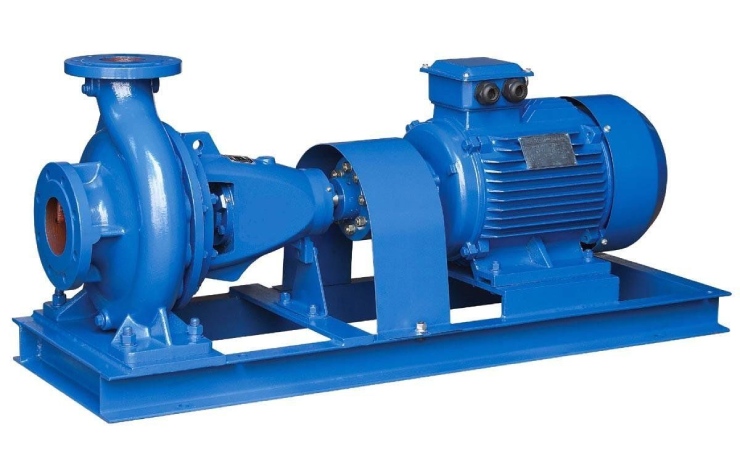Centrifugal pumps are essential components in various industries, including maritime operations. Centrifugal pump on ship plays a crucial role in the efficient transfer of fluids. Let’s delve into what centrifugal pumps are and how they work specifically in the maritime environment.
What Is A Centrifugal Pump Used On A Ship?

Centrifugal pumps play a pivotal role on ships, known for their reliability. These marine pumps are essential for cooling systems to regulate engine temperatures, adjusting ship stability through ballast transfers, and removing unwanted water from bilges. In the merchant navy, they are indispensable for propelling vessels, generating power, and supporting auxiliary machinery, ensuring overall safety and operational efficiency.
Marine Centrifugal Pump Components

The marine centrifugal pump components include the driving shaft, delivery flange, volute casing, suction flange, and impeller.
Driving Shaft
The driving shaft on a ship’s centrifugal pump serves as the link between the pump and the engine or motor. Its primary function is to transmit the rotational energy from the engine to the impeller, enabling the pump to move fluid effectively throughout the ship’s systems.
Delivery Flange
The delivery flange is a crucial component that marks the point where pressurized fluid exits the marine centrifugal pump. On a ship, this component ensures that the pressurized fluid is directed efficiently through piping systems to various destinations, such as cooling systems, ballast tanks, or other onboard equipment requiring fluid transfer.
Volute Casing
The volute casing is a key part of the centrifugal pump’s design on a ship. This curved casing surrounds the impeller and helps convert the kinetic energy generated by the impeller into pressure energy as the fluid flows through. By guiding the flow of fluid, the volute casing optimizes the pump’s efficiency and performance in maritime applications.
Suction Flange
On a ship’s centrifugal pump, the suction flange is where fluid enters the pump. This marine centrifugal pump component is connected to a suction pipe that draws in fluid from sources such as ballast tanks or the sea. The suction flange plays a critical role in ensuring a continuous flow of fluid into the pump for various onboard operations.
Centrifugal Pump Impeller
The impeller is a fundamental component of a centrifugal pump on ship. This rotating element is responsible for imparting kinetic energy to the fluid within the pump. By accelerating the fluid radially outward through centrifugal force, the centrifugal pump impeller creates the necessary flow and pressure for cooling systems, ballast operations, fuel transfer, and other essential functions on the ship.
How Does A Centrifugal Pump Work?

Upon activation, the centrifugal pump on ship undergoes a series of essential processes. Initially, the motor transforms electrical energy into mechanical energy, setting the shaft and impeller into motion. The impeller, in turn, propels the water towards the volute casing, creating a negative pressure area at its core. Through centrifugal force, the water is forced outward, acquiring kinetic energy as it flows. Transitioning through the volute casing, the water encounters a gradual increase in cross-sectional area, causing its velocity to decrease as per the principle of continuity. Consequently, this kinetic energy reduction leads to a corresponding rise in pressure energy, as dictated by Bernoulli’s theorem, crucial for the pump’s efficient functionality in various maritime applications aboard the ship.
How Does The Design of The Impeller Affect Pump Performance?
The design of the impeller plays a critical role in determining the performance of a marine centrifugal pump.
Efficiency: The centrifugal pump impeller design directly impacts the pump’s overall efficiency. Well-designed impellers can efficiently convert the input energy into kinetic energy for moving the fluid, resulting in higher pump efficiency and lower energy consumption.
Flow Rate: The impeller design affects the pump’s flow rate by determining how much fluid the pump can move within a given time. The impeller’s shape, size, and blade angles influence the flow dynamics and the pump’s capacity to handle different flow rates.
Head Generation: The impeller design influences the pump’s ability to generate head or pressure. The impeller’s geometry and configuration determine the pump’s capacity to create the necessary pressure to move fluid through the system efficiently, especially in applications where high pressure is required.
Cavitation Resistance: Proper centrifugal pump impeller design can help reduce the risk of cavitation, a common issue that can damage the pump and reduce its performance. Impellers designed to minimize cavitation tendencies improve the pump’s reliability and longevity.
NPSH Requirements: The design of the impeller can impact the Net Positive Suction Head (NPSH) requirements of the pump. A well-designed impeller can operate effectively within specific NPSH limits, ensuring optimal performance without encountering issues like cavitation.
Buy Marine Centrifugal Pump From Us

For superior marine centrifugal pumps, choose our manufacturing company. With years of marine industry expertise, we offer tailored pumps of exceptional quality. Our stringent quality control ensures pumps that meet industry standards. Customization options are available to meet specific requirements. Engineered for efficiency and performance, our pumps excel in fluid handling and durability, ideal for harsh marine conditions. Comprehensive after-sales support includes maintenance, spare parts, and technical assistance. Trust us for reliable and efficient centrifugal pumps that exceed maritime industry demands.








